French Polynesia: Clearing in with a Dog on Board
Sanne Bast and her husband Marijn love the sailing life and traveling with them on their adventures is their dog Heros. They recently arrived in Nuka Hiva, French Polynesia and having met many cruisers who were reluctant to bring their dogs to the Pacific islands due to the strict rules, found the whole process very straightforward. Due to the lack of information available for sailing pet owners wanting to do the same, they have shared their experience with Noonsite. All the following information has been checked with the French Polynesian authorities.
Published 3 years ago

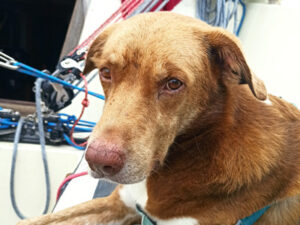
- Heros loves the sailing life.
Sailing around the world is what my husband and I would like to do with our lives – there’s no doubt about that. But for me, it is essential to take our dog Heros along on our adventures.
Heros is a mixed Greek street dog, brown with a white chest and is the size of a golden retriever. He likes to be on the boat with us and looks at the sea during crossings (he can spot gusts and is always curious when there are other animals around at sea) and at landscapes when we are at anchor. He finds the flying fish that have crashed somewhere out of sight on the boat by using his nose and he knows when to walk around the boat and when it is better to just lie down on the cockpit floor and chill. He has really turned into a great sailing dog during the last year.
However, sailing through different countries with a dog does not make customs clearance any easier and can greatly increase the costs of registering in a new country. Some countries are simply to be avoided. French Polynesia is not one of them.
We started our current journey from the Netherlands in 2021, passing through Europe to the Canary Islands, from where we sailed directly to St. Vincent and the Grenadines, as Cape Verde is considered by many countries to be a rabies-infected country, which would have made entry to St. Vincent impossible.
After visiting the French Caribbean islands and Dominica, we sailed to Panama, crossed the channel and sailed directly to Nuku Hiva. On this trip we met many people with dogs, but almost none of them sail to French Polynesia. Even in Panama, most of the boats with dogs send their pets by plane to friends or relatives, because they consider it too difficult to import the dog in to French Polynesia.
Since last year, however, importing a dog into French Polynesia has become much easier, as the health inspection of the dog can now be done in Nuku Hiva and not only in Tahiti, as before.
There is still a lot of paperwork and work to do well in advance. In my experience, it is quite difficult to find this information. Even the famous blogs written by salty sailors with a dog on board usually don’t mention the formalities concerning their dog, even though all the other minor details are described in detail.
So, I decided to write my own experience in the hope that it will help other pet owners who wish to sail in French Polynesia with their dog.
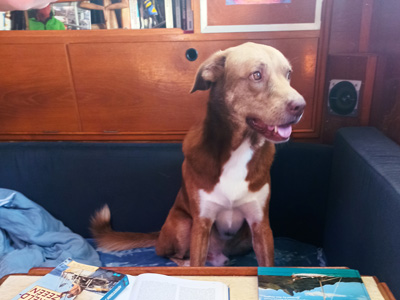

Check the current regulations
Of course, all regulations are subject to change and, as with any country you wish to visit with a pet, it is always wise to check the current regulations by emailing the relevant authorities at least a few months before you leave. I have provided current email addresses below.
Since we decided to travel with our dog, we have always given him all the vaccinations that may be required by a country. He has a European pet passport, in which the vet has noted all treatments and checks and he has a microchip. The microchip number must be included on all documents required for entry into French Polynesia.
Fear of Rabies
The biggest fear in most countries with strict rules is that a dog infected with rabies will enter
their territory. This is no different in French Polynesia. Therefore rabies vaccines must be in order (i.e.valid for the six months prior to arrival in French Polynesia) and an anti-rabies titration test must be performed in an approved laboratory. The results of this test cannot be less than three months old and not more than one year old on arrival in French Polynesia.
The dog must therefore be at least 10 months old to theoretically meet the criteria. We had this test done in the Canary Islands, which caused us some hassle because of the customs requirements for shipping animal products. Perhaps it would have been easier on the European mainland or in the French West Indies.
We were told the dog was not allowed to disembark in Panama, but on arrival in Nuku Hiva it turned out that this wasn’t necessary after all, as long as the dog is properly vaccinated (rabies at least six months before arrival in French Polynesia).
Health Certificate Checks
In Panama we had a vet carry out the health check required for the health certificate as well as a Leishmania test and internal and external anti-parasite treatment. An additional dose of antiparasitic treatment was kept on board and administered by the veterinarian in Nuku Hiva.
All documents (animal passport, animal identification number, vaccination records, rabies test results, results of the Leishmania and health certificate) as well as an import application form (form 211 A) and the Panama zarpe were then sent by email to the bio-security officer in Nuku Hiva.
Communicating with this officer before departure made things much easier on arrival, as he already knew that all our papers were in order. Also, if anything is not in order, he can tell you and you can fix the problem before departure.

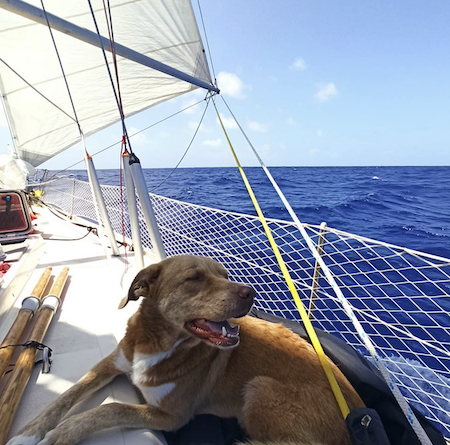
- Heros the dog at sea.
On-Board Examinations
On arrival, we emailed the bio-security officer to arrange an inspection appointment, which was arranged for the following morning. In the meantime, the dog had to stay on board. We picked up the bio-security officer and the local vet at the dock and took them to our boat. There they inspected our dog thoroughly, mainly looking for nerve problems that could indicate rabies.
They also took his temperature and examined him for eye, coat, skin or belly problems (a general examination). If the crossing was prolonged, he could also be tested for Leishmania, which requires the dog’s blood to be taken on the boat.
The veterinarian then declared our dog healthy and the bio-security officer immediately gave us the document authorizing him to land in the whole of French Polynesia. We were allowed to disembark with the dog from that moment on. The fee was 4500 francs (approx. $40).
Plan in Advance and Respect the Rules
I was quite nervous when I arrived, but in the end everything went very well. I think that if you take things seriously and plan well in advance, it is quite possible to respect the strict (understandable) rules.
In summary, I think a good plan to import your dog to French Polynesia would be the following:
- Have your dog chipped and have a passport with all its vaccinations, treatments and controls.
- Find out the exact rules in time (https://www.service-public.pf/biosecurite/import/import-animaux-vivants/chiens-et-chats/).
- Make sure your vaccinations and tests (including rabies) are done in the right time.
- Make sure your pet has a valid rabies vaccination of more than 6 months upon arrival in French Polynesia.
- Send all documents and your expected arrival date by email to the local bio-security officer.
In conclusion, I would like to make a comment on the following: I have read that some people take risks and do not register their dogs to avoid costs and hassle. Unfortunately, dogs have been killed because of this. This is not a punishment, but dogs are killed to send to the laboratory for examination on rabies. In addition to this, a fine of over 450,000 francs can be imposed and even jail time can be sentenced. People who love their dogs and respect a country and its people will therefore make the effort to comply with these demanding but achievable rules.
Useful email addresses:
- Biosecurity Nuku Hiva: yann.teikiteetini@biosecurite.gov.pf
- General biosafety of FPs: animal.impex@biosecurite.gov.pf
- Veterinarian Nuku Hiva: ludovic.verfaille@mail.pf
Email notes:
At the time I sent my email, gov.pf email addresses were not able to receive messages larger than 5 MB. I sent the documents in several emails to solve this problem. Everyone wrote in very good English (to my non-native standard). If you don’t get a response after a few days, something has probably gone wrong and you should try again.
Sanne and Marijn Bast with Heros the dog
SV Deinemeid
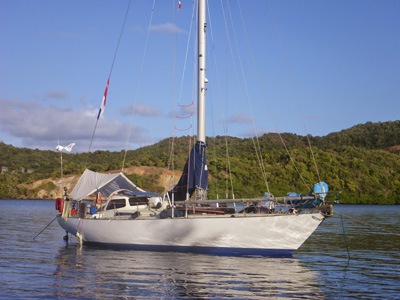

………………………………………………………………………………………………………………………………………….
About the Author
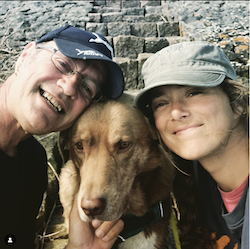

Previously they sailed around the Atlantic from 2013-2015 and now, having sold everything they owned in their home country, are full-time sailors living on board their yacht, a Philips 43, designed by Holman & Pye and built in Dartmouth in the mid 70s.
……………………………………………………………………………………………………………………………………….
Related Links:
- Cruising with Pets Noonsite page
- Portrait of a Cruiser: Dog Chloe from SY Mojito
- How to take your Dog or Cat sailing (Yachting Monthly – Jan 2021)
- Cruising and Sailing with Pets Facebook Page
……………………………………………………………………………………………………………………………………….
The opinions expressed in this article are the author’s own and do not reflect the view of Noonsite.com or World Cruising Club.
Related to following destinations: Canary Islands, French Polynesia, Marquesas, Nuku Hiva, Panama, St. Vincent & the Grenadines
Related to the following Cruising Resources: Cruising with Pets


